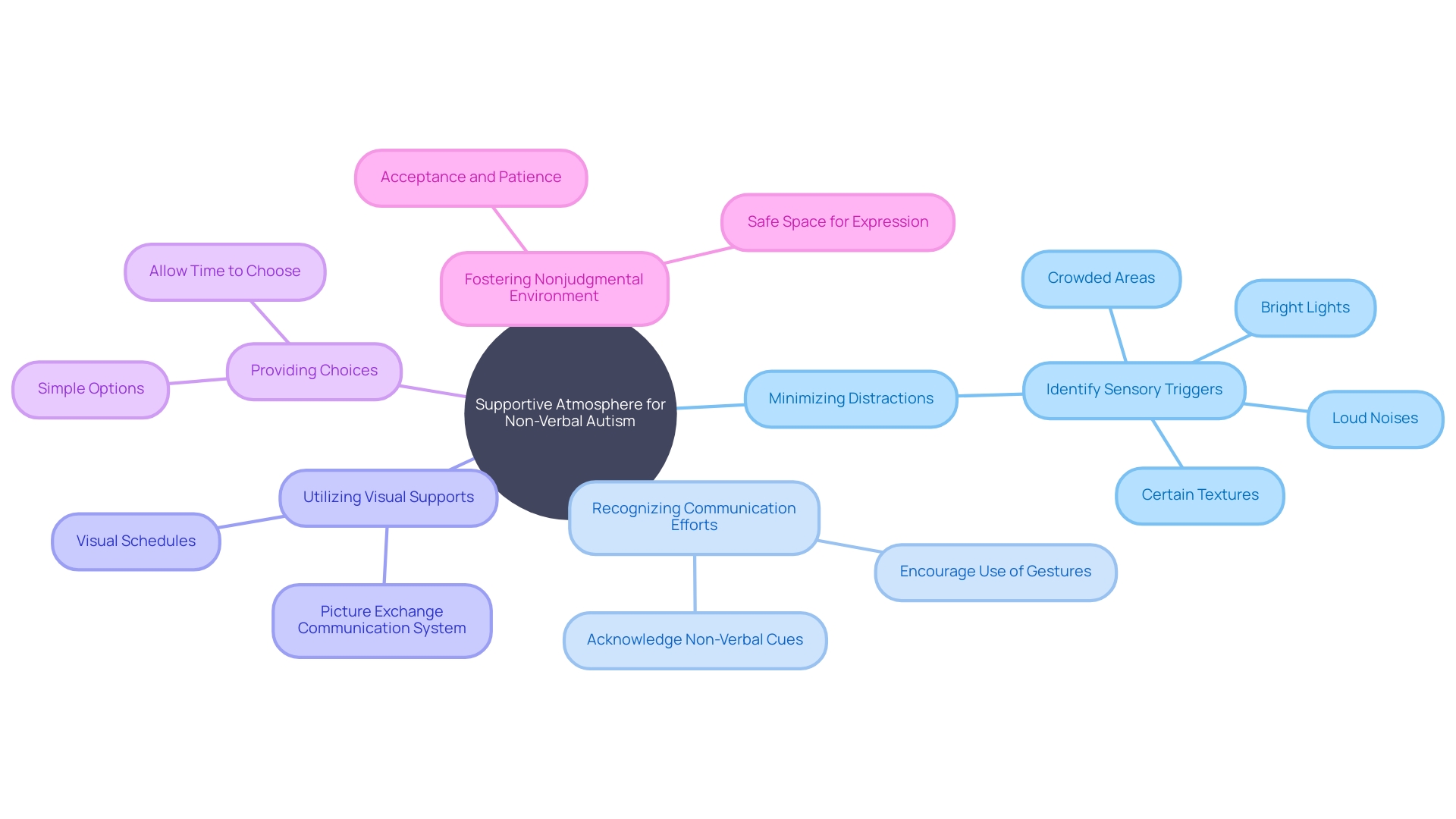Introduction
Individuals with nonverbal autism may not speak, but their ability to understand and process the world around them can be profound. They express themselves in alternative ways, such as through body language—a person's involuntary behaviors like facial expressions, posture, and physical gestures can often convey more than words. The power of nonverbal communication was notably highlighted when a non-speaking autistic teen used a preschool alphabet toy to type a message, revealing his acute awareness and need for help despite his apparent behavioral challenges.
Advancements in technology have been a game-changer for those with nonverbal autism. For instance, picture boards and communication apps on tablets have enabled individuals like Joshie and Jordyn Zimmerman to share their thoughts and engage with others. Zimmerman's use of an iPad app not only broke her silence but also propelled her into becoming a disability rights educator.
Similarly, Mr. Harris's campaign for picture boards in Peterborough demonstrated that a small investment in such technology could have a transformative impact on communication capabilities.
These innovations are crucial because genuine interaction is not limited to spoken words. As research on smiles has shown, genuine expressions of emotion involve subtle muscle movements that are not present in insincere gestures. This suggests that even in the absence of speech, communication is still rich and complex.
By understanding and utilizing diverse communication methods, including body language and technology, we can better connect with and support nonverbal individuals within the autism community.
Understanding Nonverbal Autism
Individuals with autism who do not speak may not speak, but their ability to understand and process the world around them can be profound. The express themselves in alternative ways, such as through body language—a person's involuntary behaviors like facial expressions, posture, and physical gestures can often convey more than words. The power of nonverbal interaction was notably highlighted when a non-speaking autistic teen used a preschool alphabet toy to type a message, revealing his acute awareness and need for help despite his apparent behavioral challenges.
Advancements in technology have been a game-changer for those with nonverbal autism. For example, picture boards and apps on tablets have allowed individuals like Joshie and Jordyn Zimmerman to share their thoughts and interact with others. Zimmerman's use of an iPad app not only broke her silence but also propelled her into becoming a disability rights educator. Likewise, Mr. Harris's initiative for picture boards in Peterborough showed that a minor investment in such technology could have a transformative effect on capabilities.
These innovations are crucial because genuine interaction is not limited to spoken words. As research on smiles has shown, genuine expressions of emotion involve subtle muscle movements that are not present in insincere gestures. This implies that even without speech, interaction remains abundant and intricate. By understanding and utilizing diverse methods of interaction, including body language and technology, we can better connect with and support individuals without verbal expression within the autism community.
Key Communication Strategies for Nonverbal Autistic Individuals
Modifying methods of interacting with autistic people who have limited or no verbal abilities frequently requires inventive techniques and resources that address their distinct requirements. Visual aids like picture schedules and message boards serve as tangible representations of information, making it easier to comprehend and convey thoughts and needs. Additionally, Augmentative and Alternative Communication (AAC) devices leverage technology to provide a voice for those who cannot speak, using symbols, pictures, or text to foster interaction.
The Picture Exchange Communication System (PECS) empowers people who cannot speak by instructing them to use images or symbols to express their desires, promoting both understanding and agency in expressing themselves. Sign language and Makaton, employing gestures and symbols, offer alternative avenues for expression, transcending the limitations imposed by the inability to vocalize thoughts.
It is important to use clear and concise language when engaging with individuals who do not speak, minimizing the complexity of sentences and focusing on direct communication. This approach mirrors the efforts of non-native English speakers who, through a shared commitment to understanding, develop new linguistic norms on the fly, ensuring effective interaction despite diverse backgrounds.
Efforts like Communication 4 ALL, spearheaded by nonspeaking advocate Elizabeth Bonker, illuminate the profound capabilities of individuals with nonspeaking autism to communicate via typing, challenging preconceived notions and advocating for their right to education and self-expression. Instances like the adolescent client who typed 'assist me it's painful' utilizing an alphabet toy, underscore the urgency and impact of improving our methods of conveying to genuinely listen to those who cannot speak.
In the quest for meaningful interaction, it is essential to consider the physiological complexities of speech production, recognizing the intricate coordination required among the vocal tract, articulators, and respiratory system. This comprehension enhances our gratitude for other means of interaction and strengthens the significance of cultivating understanding and flexible environments for empathy.
Nonverbal Interaction Techniques: Imitation and Body Language
Engaging with nonverbal individuals on the autism spectrum requires innovative and understanding strategies for interacting. Mimicking the behaviors of the autistic person, known as imitation, can be a powerful way to foster connection and express understanding. This technique goes beyond simple mimicry; it's about engaging in a dialogue without words, where actions echo back and forth, creating a rhythm of communication that can be deeply reassuring and affirming.
Similarly, being attuned to body language is crucial. Nonverbal individuals may rely heavily on facial expressions, gestures, and other physical movements to convey their feelings and needs. These cues can be subtle yet profoundly telling, offering a window into their experiences. For those seeking to communicate, it's equally important to be aware of how their own signals that are not expressed through words might be interpreted. The interaction of silent yet expressive body movements is a delicate dance, one that demands sensitivity and attentiveness.
A novel method of conveying messages without using words has been showcased through the utilization of augmented reality (AR) applications. Such technology can translate tactile sensations into visual and auditory signals, catering to the heightened visual and auditory processing abilities often found in the autistic community. This adjustment emphasizes the significance of engaging people who rely on gestures and body language in their preferred environments and utilizing technology to overcome communication barriers.
The importance of these interaction techniques has been echoed in the experiences of individuals with autism who have become advocates and researchers in their own right. Their insights challenge the traditional deficit-focused narrative and highlight the need for interventions that respect and harness the unique advantages of autistic ways of processing the world. As we further explore and comprehend the intricacies of expressing without words within the autism spectrum, it is crucial to pay attention to and gain knowledge from the encounters of those who navigate these obstacles on a daily basis.
Creating a Supportive Communication Environment
Creating a supportive atmosphere for people with autism who have difficulty expressing themselves verbally is crucial. By utilizing specific tactics, we can enhance improved correspondence and backing for these people. Minimizing distractions is a foundational step; this involves creating a tranquil space by reducing background noise and adjusting lighting conditions to help focus on the exchange of information. Recognizing and encouraging every effort to communicate is crucial. It's a way to bolster their confidence and acknowledge their efforts, reinforcing the importance of their voice in the world. Visual supports, like schedules, are invaluable tools that can provide clarity around daily activities and serve as cues for initiating conversation. Providing choices empowers individuals who have difficulty speaking, giving them a sense of autonomy. This can be accomplished through pictures, gestures, or other alternative methods of conveying information. Finally, fostering a nonjudgmental environment is perhaps the most critical element. It's a space where every attempt to connect is valued, and 'mistakes' are embraced as part of the learning process. These approaches not only honor the uniqueness of individuals with limited verbal abilities but also promote their engagement and self-assertion in a society that frequently revolves around spoken interaction.

Early Intervention and Collaboration with Professionals
Early intervention and engagement with specialized therapists significantly enhance the lives of nonverbal autistic individuals. It's important to take proactive steps:
-
Tailored support and therapies from early intervention services are crucial for developing language skills and overall growth.
-
Speech-Language Pathologists: These professionals are crucial for evaluating and intervening in challenges related to speech and language. They work to create customized plans that cater to individual needs.
-
Occupational Therapists specialize in enhancing fine motor skills and sensory integration, promoting successful interaction. They focus on sensory or motor difficulties that may impede effective interaction.
-
Educators and Support Staff: A unified approach with educators ensures that consistent messaging strategies are employed. Sharing successful techniques across various environments is key to building a strong support network.
-
Parent Support Groups: Connecting with fellow parents through support groups provides emotional support and shares valuable experiences and resources.
The remarkable story of Mr. Harris, whose son began to communicate using an electronic tablet, underscores the transformative power of technology in the lives of nonverbal autistic individuals. His support has resulted in the implementation of picture boards, demonstrating that even small investments can have significant effects on abilities to interact.
Likewise, Jordyn Zimmerman's journey from being non-verbal to becoming an educator and disability rights advocate through the use of an iPad app highlights the potential of augmentative communication tools. It's an example that demonstrates the necessity for such technology to be accessible to all.
These personal stories, combined with the efforts of organizations like the IACC and AT-Newswire, highlight the importance of community and technology in supporting individuals with limited verbal communication who have autism. With the understanding that the majority of reasonable accommodations for individuals with autism are cost-free and the benefits they bring to workplaces, it's clear that supporting nonverbal individuals is not just a moral imperative but also a practical one.
Research syntheses indicate that many intervention studies for autistic children have design flaws, which highlights the importance of high-quality intervention research. This research is vital for understanding the effectiveness of interventions and ensuring the respect and well-being of people with autism.

Conclusion
In conclusion, individuals with nonverbal autism have a profound ability to understand and communicate through body language and alternative methods. Technology advancements, like picture boards and communication apps, have greatly enhanced their ability to express themselves and engage with others.
Genuine interaction goes beyond spoken words, as research on smiles has shown. Understanding and utilizing diverse communication methods, including body language and technology, allows for better connection and support within the autism community.
Adapting communication approaches involves innovative strategies and tools such as visual aids, AAC devices, PECS, sign language, and Makaton. Clear and straightforward language is crucial, and efforts like Communication 4 ALL challenge preconceived notions and advocate for education and self-expression.
Imitation and understanding body language are powerful techniques for fostering connection. Augmented reality applications show promise in bridging communication gaps. The insights of nonverbal advocates challenge deficit-focused narratives and highlight the importance of interventions that respect their unique ways of processing the world.
Creating a supportive communication environment involves minimizing distractions, celebrating attempts at communication, providing visual supports and choices, and fostering a nonjudgmental atmosphere. Early intervention and collaboration with professionals greatly enhance the lives of nonverbal autistic individuals.
Supporting nonverbal individuals is not only a moral imperative but also a practical one, as reasonable accommodations for autistic employees bring benefits to workplaces. High-quality intervention research is crucial for understanding effectiveness and ensuring the well-being of people with autism.
By embracing diverse communication methods and fostering inclusive environments, we can empower and support nonverbal individuals within the autism community. Together, we can create a world that values and respects the unique communication needs and abilities of every individual.




